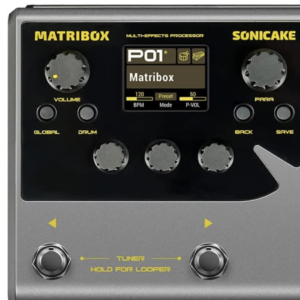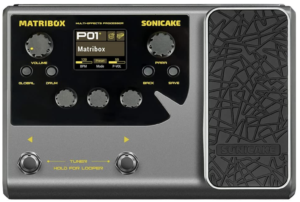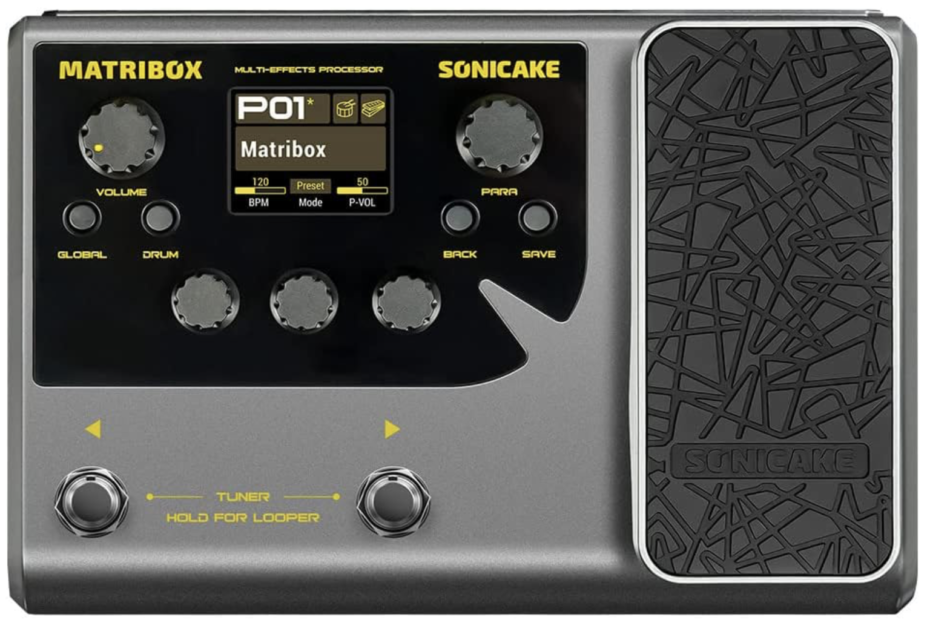The SONICAKE Multi Effects Processor with Expression Pedal is a compact pedalboard-style unit designed for electric guitar and bass players. It offers a wide range of built-in effects and features, including an expression pedal for real-time control over various parameters.
This article gives an overview of the key features and functions of the SONICAKE Multi Effects Processor.
Multi-Effects
 The SONICAKE pedal [link] combines multiple effects into a single unit, allowing you to access a diverse palette of sounds. Common effects include distortion, overdrive, delay, reverb, chorus, phaser, flanger, tremolo, and more. This means you can experiment with various tones and textures without the need for individual effect pedals.
The SONICAKE pedal [link] combines multiple effects into a single unit, allowing you to access a diverse palette of sounds. Common effects include distortion, overdrive, delay, reverb, chorus, phaser, flanger, tremolo, and more. This means you can experiment with various tones and textures without the need for individual effect pedals.
This pedal offers a wide range of effects commonly found in guitar and bass signal chains. Here are some of the effects you might find in such a pedal:
- Distortion and Overdrive: Various distortion and overdrive effects, including classic, bluesy, high-gain, and modern distortion tones.
- Modulation Effects: Effects like chorus, flanger, phaser, and tremolo that add movement and texture to your sound.
- Delay: Delay effects produce echo and repeat patterns, with options for digital delay, analog delay, and tape echo simulations.
- Reverb: Reverb effects simulate different room, hall, and ambient reverberation characteristics to add depth to your sound.
- Wah-Wah: The built-in expression pedal can often be assigned to control a wah-wah effect for classic filter sweeps.
- Pitch Shifting: Pitch shift effects, including octave up, octave down, and harmonization, can create unique tonal textures.
- Equalization (EQ): Parametric and graphic EQ options for shaping your tone by adjusting bass, midrange, and treble frequencies.
- Volume: Control your volume level and create volume swells and fades.
- Compressor: Compressor effects can even out your guitar’s dynamic range, providing sustain and control.
- Noise Gate: Noise gate effects help reduce unwanted noise and hiss in your signal chain, particularly when using high-gain or distortion effects.
- Rotary Speaker: Simulates the sound of a rotating Leslie speaker often used with organs and electric guitars.
- Auto Wah: Provides automatic wah-wah filtering without the need to manually control a wah pedal.
- Flanger: Classic flanger effects for adding swirling modulation to your sound.
- Tremolo: Tremolo effects create rhythmic volume modulation.
- Octaver: Octave effects add octave-up or octave-down notes to your guitar signal.
- Phaser: Phaser effects create sweeping phase shifts in your tone.
- Filter: Filter effects shape your sound by controlling frequency responses.
- Pitch Whammy: Provides pitch-bending and whammy bar-style effects.
- Looper: Some models may include a built-in looper for recording and playing back loops or backing tracks.
- Amp Modeling: Depending on the version, the pedal might include amp modeling with various amplifier and cabinet simulations.
Also Read:
MOOER GE100 Multi-effects Guitar Processor Pedal Review
MXR Clone Looper Guitar Effects Pedal: Review
MOOER Prime P1 Guitar Multi-Effects Processor Review
Boss GT-1 Guitar Multi-effects Pedal
LEKATO Multi Effects Guitar Pedal
Line 6 Helix Guitar Effects processor Review
Best Multi effects Pedal for Guitar: Review
Expression Pedal
 One of the standout features of this unit is the integrated expression pedal. The expression pedal can be assigned to control parameters such as volume, wah-wah, pitch modulation, and more. This hands-free control enhances your playing dynamics and expressiveness.
One of the standout features of this unit is the integrated expression pedal. The expression pedal can be assigned to control parameters such as volume, wah-wah, pitch modulation, and more. This hands-free control enhances your playing dynamics and expressiveness.
The expression pedal in the SONICAKE Multi Effects Processor with Expression Pedal [pedal] is a versatile feature that adds significant functionality to the unit. An expression pedal is typically a foot-controlled device that allows you to manipulate various parameters of your effects in real-time. Here’s an overview of the expression pedal in this pedal:
The expression pedal can be assigned to control a specific parameter or effect parameter of your choice within the multi-effects processor. This parameter can vary depending on the effect you’re using. Common assignments include volume, wah-wah, pitch modulation, and more.
One of the most common uses of the expression pedal is to control a wah-wah effect. When assigned to wah-wah, rocking the expression pedal forward and backward simulates the classic wah-wah sound, allowing you to achieve dynamic filter sweeps.
The expression pedal enables you to make real-time adjustments to the effect parameter it’s controlling. This means you can change the intensity, speed, or depth of an effect while playing, providing enhanced expressiveness and creativity in your performance.
Controlling the Expression Pedal
 Assigning the expression pedal to control volume allows you to perform volume swells, fades, and dynamic changes during your playing. This can add dynamics and drama to your guitar solos.
Assigning the expression pedal to control volume allows you to perform volume swells, fades, and dynamic changes during your playing. This can add dynamics and drama to your guitar solos.
Some pedals allow you to assign the expression pedal to control pitch modulation effects, such as pitch shifting or whammy effects. This feature is valuable for creating pitch bends and unique pitch effects.
The pedal typically features an easy calibration process, where you set the pedal’s minimum and maximum values for the assigned parameter. This calibration ensures precise control and a smooth range of motion.
The expression pedal is a versatile tool that can be used with a wide range of effects and parameters, making it adaptable to different playing styles and musical genres.
Some expression pedals come equipped with a toe switch, allowing you to engage or disengage specific effects or functions by pressing down on the pedal’s toe. This can be handy for toggling effects on and off without bending down to reach individual footswitches.
SONICAKE expression pedals are typically built to be robust and durable, ensuring reliable performance underfoot during gigs and rehearsals.
Whether you’re a guitarist or bassist, the expression pedal can be a valuable addition to your effects setup, enhancing your playing dynamics and overall sound control.
Other Features
Compact and Portable: The pedal is designed in a compact and pedalboard-friendly form factor, making it easy to fit into your existing pedalboard setup or carry with you for gigs and rehearsals.
User-Friendly Interface: The SONICAKE Multi Effects Processor typically features an intuitive interface with an LCD screen and dedicated knobs and buttons for adjusting settings. This user-friendly design simplifies the process of selecting and fine-tuning your effects.
Presets: You can save and recall your custom presets, allowing you to access your favorite combinations of effects quickly. This feature is convenient for live performances when you need to switch between different tones seamlessly.
Amp Modeling: Some versions of the SONICAKE processor may include amp modeling capabilities. This means you can simulate the sounds of various amplifier types and speaker cabinets, giving you access to a wide range of amp tones.
Versatile Connectivity: The unit typically offers various input and output options, including a standard guitar input, stereo outputs for connecting to amplifiers or recording interfaces, and an auxiliary input for playing along with external audio sources.
USB Connectivity: You can often connect the pedal to a computer via USB for firmware updates, sound edit
Comparable Pedals
There are several comparable multi-effects pedals with expression pedals on the market that offer a range of features and effects for guitarists and bassists. Here are some popular alternatives to the SONICAKE Multi Effects Processor with Expression Pedal:
- Zoom G3Xn: The Zoom G3Xn is a versatile multi-effects processor with a built-in expression pedal. It offers a wide range of effects, amp modeling, and amp/cabinet simulation. The pedal is known for its ease of use and high-quality sound.
- Line 6 HX Stomp: While a bit more compact, the Line 6 HX Stomp is a powerful multi-effects processor with amp modeling and cab simulation capabilities. It includes an expression pedal input and offers a vast array of effects and amp models.
- BOSS GT-1: BOSS is renowned for its guitar effects, and the GT-1 is no exception. This compact multi-effects pedal includes an expression pedal input and offers a wide variety of effects, amp models, and user-friendly operation.
- Mooer GE200: The Mooer GE200 is a feature-packed multi-effects processor with amp modeling and a built-in expression pedal. It’s known for its compact size and comprehensive effects library.
- Digitech RP360XP: The Digitech RP360XP features an expression pedal and a broad selection of effects. It’s user-friendly and suitable for players looking for a straightforward multi-effects solution.
- NUX MG-100: The NUX MG-100 is an affordable multi-effects pedal with a built-in expression pedal. It offers a range of effects and amp models, making it a budget-friendly choice for beginners.
- Hotone Ravo MP-10: The Hotone Ravo MP-10 is a compact multi-effects processor with an expression pedal. It’s known for its portability and easy-to-use interface.
- Digitech Element XP: The Digitech Element XP is a budget-friendly multi-effects pedal with an expression pedal. It’s designed for beginners and offers essential effects for practice and experimentation.
- Vox StompLab IIG: The Vox StompLab IIG is a compact multi-effects pedal with a built-in expression pedal. It features a variety of amp models and effects suitable for both guitar and bass players.
- Zoom G1X Four: The Zoom G1X Four is a compact and affordable multi-effects pedal with an expression pedal. It offers a wide range of effects, amp models, and drum patterns.
